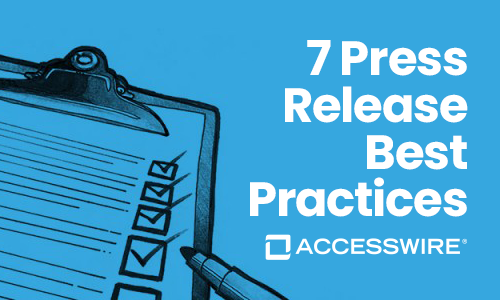What is a Digital Newsroom?
Back in the olden days (i.e., before the Internet), the newsroom was where print or broadcast journalists congregated to write and deliberate on which stories of the day were worth pipelining to the public.
While the titans of print and TV media still hold considerable clout in dictating which stories get noticed, the worldwide web has given businesses some extra room to represent themselves directly to their target audience—without the go-ahead from old school media gatekeepers.
Enter the digital newsroom.
PR 101: What is an Online Newsroom
An online or digital newsroom is a web page on your company site that aggregates all of your media assets into a single stream of content, including:
- Press releases
- Brand news
- Facts, stats, and number sheets
- Related stories in your industry
In its most distilled essence, an online newsroom is one of the tools of public relations that shapes the space you occupy, the stories you tell, and the identity you embody to both journalists and your stakeholders. And there are a few essential practices for curating your digital newsroom so that your brand gets recognized—and remembered—on your own terms.
Why Newsrooms are Going Digital
Pre-internet, the standard industry practice for journalism was to choose and editorialize news stories in accordance with their given medium: print, TV, or radio.
Stories were organized and formatted to convey what information was most pressing—and keep as much of their target audience’s attention as possible.
These days, brands are having to adapt to a “Wild West” style media landscape, where there’s content as far as the eye can see, but visibility is chiefly dictated by algorithms.1 To that end, it can be challenging for brands to get a word in edgewise and attract their public’s attention.2
However, journalists still have to choose and craft stories—and expectations for their output are higher than ever before.
By creating an online newsroom, not only can you manage your brand identity with more facility, but you can also take some of the tedious work off reporters’ plates by giving them exactly what they need to put a story together. The digital newsroom smooths over the gap between your brand and the onerous work required to get your message out to the public.
The Advantages of Building an Online Newsroom
The fact is that internet users are overwhelmed by the swarm of news headlines constantly jockeying for their attention.
More and more, the public is looking for trusted voices in the news media landscape, and are—whether they know it or not—building ongoing, dynamic relationships with public figures, brands, and their affiliates.
Building a digital newsroom can give your company an edge in five critical ways:
- Synchronizing your brand image – A digital newsroom gives customers, clients, partners, and your employees one reliable touchpoint to receive your company message, straight from the horse’s mouth.
- Customizing your message – With an online press kit, you can optimize your ability to sculpt your message per your brand’s short- and long-term goals.
- Simplifying journalist’s workflow – The digital newsroom is an alternative to print-era newsrooms, which is particularly important for work-from-home or freelance journalists who want to write about your company.
- Simplifying your workflow – Digital newsrooms communicate company news to your employees as well as your media contacts—and can save you the extra legwork on media follow-ups by deploying cutting-edge data analytics.
- Track your progress – With a digital newsroom, you can oversee trends in readership and interest, tracking which stories are hitting home with readers and which turn them off. What’s more, you’ll have an accessible archive of relevant stories to track your company’s growth.
Each of these factors works to hone your message, enhance your media relations, and equip your business with the tools to figure out where you’re succeeding, and where you can tighten the bolts.
5 Key Digital Newsroom Elements
Unlike the brick-and-mortar newsrooms of yesteryear, setting up a digital press room does not have to be chaotic. There are five key elements your digital newsroom structure should hit to help your brand expand its relationships with all of your stakeholders, from top to bottom.
Element #1: Brand Profile
When it comes to your digital newsroom, all roads should lead back to your company. Meaning: it should not be difficult for your reader—whether they’re a customer or a journalist—to find information about your brand identity and brand mission.
Your digital newsroom should have a lucid and succinct profile (a boilerplate) about your company. This should include any (or all) of the following:
- When or how your company was founded
- Your company mission, vision, or highest good
- Eye-catching stats or data to illustrate your impact
- Notable company milestones
- Your company leadership
- A CTA (call to action)
Crafting a concise sum-up of your brand can help to increase brand awareness, hone your image, and even save journalists the work of condensing your brand message on their own.
Element #2: Content
Where your brand profile establishes who is doing the talking, the content you make available on your digital newsroom conveys your message.
Online newsroom content typically falls into the following categories:
- Press release
- Data, facts, and statistic briefs
- Earned media
- Press kits
- Industry news
Remember, your digital newsroom is not the same as your company blog or social media flow.
There’s no need to include every bit of news related to your business or each press release. Your audience is already deluged in media input, so it behooves you to be judicious about which stories you deem relevant—and advantageous—to feature in your company press room.
Element #3: Legibility
No matter what kind of content you choose to collate in your online newsroom, all of it should appeal to your audience’s screen-weary eyes.
To appeal to your lay readers, be sure that your press releases are clean, crisp, and free of industry jargon. Your sentences should be digestible, with no rambling paragraphs to deter your readers’ attention.
As for journalist readers, you’ll increase your chances of press write-ups if you furnish them with everything they need to craft their story. As mentioned, assembling press kits to live on your digital newsroom is an excellent way of minimizing the extra legwork reporters have to do to craft a publishable piece. So, what is a press kit?
A solid press kit can include any (or all) of the following:
- Brand bio
- Brand logos
- High-resolution company media (photography and video)
- High-quality headshots of key leaders, products, or events
- Mentions of any company accolades
- A company representative’s contact information
Navigating how to make a press kit requires a bit more work and expenses to put together, but they can be a worthwhile measure of enhancing optics, brand awareness, and your media relations.
Lastly, make sure your digital newsroom presents well on desktop, tablet, and mobile interfaces. As of 2021, more than half of the Internet traffic churn comes from mobile devices, so you’ll want to make sure your digital content is optimized for all modes of access.3
Element #4: Social Presence
The best way to reach your audience is to encounter them where they spend the most time: their social media feed. As such, it should come as no surprise that weaving your business’ social media presence into your online press room is essential.
While your digital newsroom should display earned media, your social media platforms are better suited to circulating your company’s owned media. The informal, discursive atmosphere of social media lends itself to a less “formal” brand representation, enabling you to reach and build trust with your public in new ways.
In addition to providing your company handles for Instagram, Twitter, YouTube, TikTok, Facebook, and other platforms, don’t forget to make use of the handy “Subscribe” button at the bottom of each page. Let your subscribers know what they’re in for—be it company newsletters, press releases, blog posts, etc.—and, if possible, check in with the media contacts who follow you to get their feedback on the digital content you provide.
Element #5: Analytics
Your last step in minting an impeccable, strategic, and user-friendly digital newsroom is to make sure you have the right analytical apparatus in place to track how well it performs.
With data analytics, you’ll be able to scan your online newsroom for:
- Which of your stories are gaining the most traction
- Which media assets are getting the most views and downloads
- What times of the day and week your traffic ranks the highest (and the lowest)
- Who is picking up your stories, and how they got there
- Your digital newsroom’s most frequent visitors
And more — if you choose the right platform to oversee your online press room.
Build and Boost Your Digital Newsroom with ACCESSWIRE
Your digital newsroom is the motherboard of your digital PR conduct. It’s where you can publish, curate, and provide the touchstones for your contacts—be they media makers or media consumers—to get to know you and for you to get to know them.
ACCESSWIRE provides companies a complete suite of tools to help them optimize their visibility at every stage of the PR cycle:
- Press release distribution
- Digital newsroom
- Data analysis
Your digital newsroom should be a dynamic, progressive engine in telling the story of your company. Drop us a line to learn how our press release service can help you broaden your reach, sharpen your voice, and send a message with both integrity and disruptive potential.
Sources:
Search Engine Journal. How Do Algorithms Work? A Basic Primer for Non-Marketer.
Columbia Journalism Review. How algorithms decide the news you see.
Statista. Percentage of mobile device website traffic worldwide from 1st quarter 2015 to 1st quarter 2021.
Similar Blog Posts
PRODUCTS
ACCESSWIRE | All Rights Reserved




